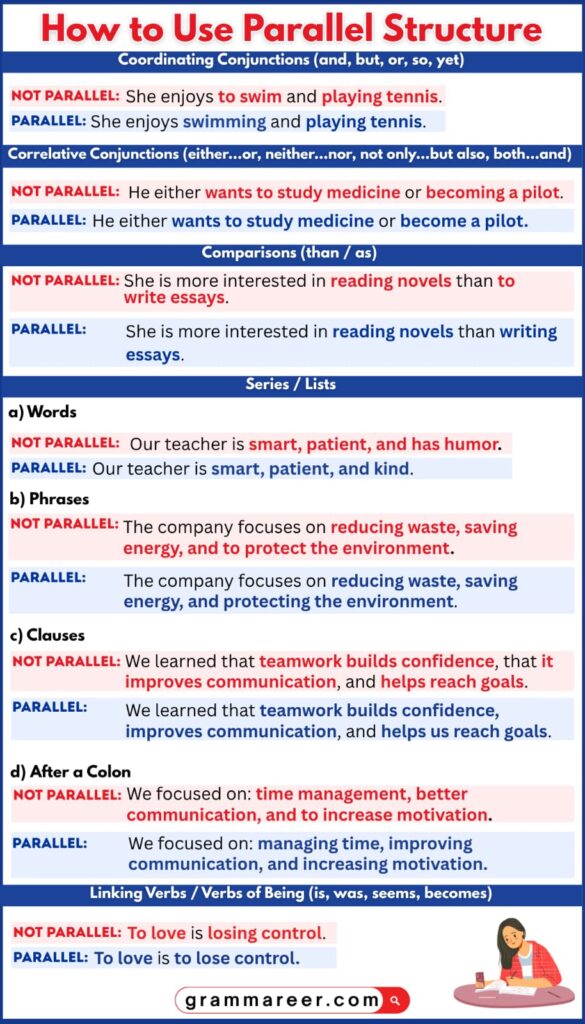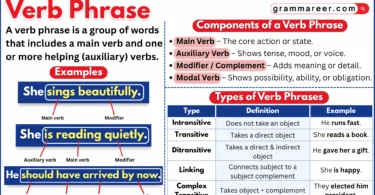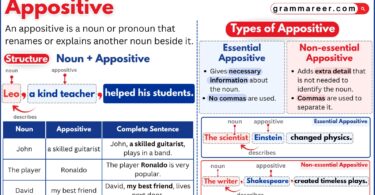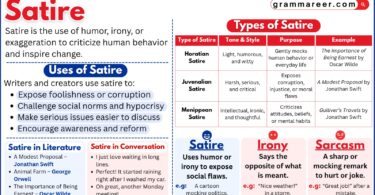In English grammar, parallel structure (also known as parallelism) means using the same grammatical pattern for words, phrases, or clauses within a sentence. It adds balance, rhythm, and clarity to writing, making ideas easier to follow and more pleasant to read. Sentences that lack parallelism often sound awkward or confusing, while those that follow this structure feel smooth and well-organized.
In this article, the concept of parallel structure, its rules, and examples will be discussed in detail.
Table of Contents
What Is Parallel Sentence Structure?
In English grammar, parallel structure (also known as parallelism) refers to using the same grammatical pattern in two or more parts of a sentence. This structure makes writing clear, balanced, and easier to understand.
- Not parallel: She likes reading, to cook, and dancing.
- Parallel: She likes reading, cooking, and dancing.
Maintaining parallel structure helps a writer create smooth and organized sentences. While non-parallel sentences are not always grammatically incorrect, they often sound awkward or uneven. Parallelism is commonly used in lists, paired ideas, and headings to make writing more natural and consistent.

How to use parallel structure?
Parallel structure makes writing flow smoothly by keeping similar ideas in the same grammatical form. It’s especially important when connecting phrases or clauses with conjunctions, comparisons, or lists. Let’s look at how it works in different situations.
Parallel Structure with Coordinating Conjunctions
When two or more ideas are joined by and, but, or, so, or yet, each part of the sentence should follow the same grammatical form. This keeps the sentence even and clear.
For Example:
- Not parallel: She enjoys to swim and playing tennis.
- Parallel: She enjoys swimming and playing tennis.
Parallel Structure with Correlative Conjunctions
Correlative conjunctions such as either…or, neither…nor, not only…but also, and both…and should connect ideas that have the same structure. When one part uses an infinitive, phrase, or clause, the other part should match it.
For Example:
- Not parallel: He either wants to study medicine or becoming a pilot.
- Parallel: He either wants to study medicine or become a pilot.
Parallel Structure with Comparisons
When we compare ideas using than or as, both parts of the comparison need to follow the same form. This helps create balance and clarity.
For Example:
- Not parallel: She is more interested in reading novels than to write essays.
- Parallel: She is more interested in reading novels than writing essays.
By keeping our sentences parallel in these ways, we make them more consistent and pleasant to read.
Parallel Structure in a Series
Parallel structure also plays a big role when we write items in a series. A series usually includes two or more similar ideas connected by commas, semicolons, or conjunctions like and or or. Using the same grammatical pattern for each item makes our writing sound logical and well-organized.
Parallel Words
When listing words, it’s important that all items belong to the same part of speech. Nouns should go with nouns, adjectives with adjectives, and verbs with verbs.
For Example:
- Not parallel: Our teacher is smart, patient, and has a great sense of humor.
- Parallel: Our teacher is smart, patient, and kind.
Parallel Phrases
When we use a series of phrases, all of them should follow the same pattern. Mixing different structures makes writing sound uneven.
For Example:
- Not parallel: The company focuses on reducing waste, saving energy, and to protect the environment.
- Parallel: The company focuses on reducing waste, saving energy, and protecting the environment.
Parallel Clauses
Sometimes a sentence includes several clauses (ideas with a subject and verb). These should also follow the same structure for better flow.
For Example:
- Not parallel: We learned that teamwork builds confidence, that it improves communication, and helps reach goals.
- Parallel: We learned that teamwork builds confidence, improves communication, and helps us reach goals.
Lists After a Colon
When we introduce a list after a colon, every item in that list should match in form. This keeps the structure neat and professional.
For Example:
- Not parallel: We focused on three main goals: time management, better communication, and to increase motivation.
- Parallel: We focused on three main goals: managing time, improving communication, and increasing motivation.
Parallelism in a series helps create order, clarity, and rhythm in our writing. It also shows that each idea carries equal importance, which strengthens the message we want to share.

Rhetoric and Parallelism
Parallelism is not only used to balance sentences but also to make writing more persuasive. In rhetoric, which focuses on influencing and inspiring others, repetition of words or sentence patterns adds rhythm and strength to our message. It makes our ideas flow naturally and sound more powerful.
For example:
- We came, we saw, we conquered.
- Tell me and I forget, teach me and I remember, involve me and I learn.
These sentences sound smooth and memorable because of their repeated structure. Parallelism in rhetoric helps us express ideas clearly and leave a lasting impact on the reader or listener. In this article, we’ll see how this technique can make our writing more expressive and effective.
Common Parallelism Mistakes
Sometimes, we break the rule of parallelism without even noticing. These mistakes make our sentences sound a bit off or confusing. Let’s look at some common ones and see how to fix them.
1. Verb Forms:
We often mix different verb forms without realizing it.
For Example:
| ❌ Not Parallel: | ✅ Parallel: |
| Our teacher told us to read the story, writing a summary, and to discuss the theme. | Our teacher told us to read the story, to write a summary, and to discuss the theme. |
2. Mixing Nouns and Verbs:
Using a noun and a verb in the same list breaks the pattern.
For Example:
| ❌ Not Parallel: | ✅ Parallel: |
| I enjoy painting landscapes and to visit art galleries. | I enjoy painting landscapes and visiting art galleries. |
3. Singular and Plural Nouns:
When using lists, make sure all nouns match in number.
For Example:
| ❌ Not Parallel: | ✅ Parallel: |
| The zoo has lions, elephants, and a monkey. | The zoo has lions, elephants, and monkeys. |
4. Different Parts of Speech:
Mixing adverbs, adjectives, or phrases can throw off the balance.
For Example:
| ❌ Not Parallel: | ✅ Parallel: |
| She completed the task quickly and with great care. | She completed the task quickly and carefully. |
5. Unrelated Ideas:
Sometimes sentences include ideas that just don’t fit together.
For Example:
| ❌ Not Parallel: | ✅ Parallel: |
| He finished his project and went to buy ice cream. | After finishing his project, he went to buy ice cream to celebrate. |
FAQs about Parallel Structure
Parallel structure means using the same grammatical pattern for related words, phrases, or clauses in a sentence. It makes writing smoother and easier to read.
Example:
She likes reading, writing, and traveling.
Read your sentence aloud and see if it sounds balanced. If you notice mixed forms like “to run, swimming, and danced,” it’s not parallel.
Correct it to: to run, to swim, and to dance (or running, swimming, and dancing).
Parallel structure improves clarity and rhythm in writing. It helps readers understand ideas easily and makes sentences sound more natural and professional.
You May Also Like




